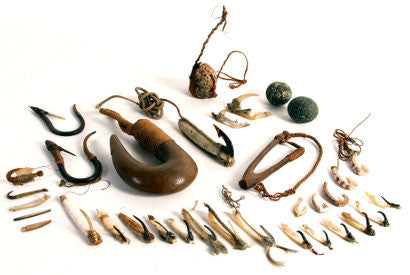We've already reported on one of the great Maori highlights coming up at Webb's African and Oceanic art auction: a pou tokomanawa figure credited to Anaha Te Rahui of the Ngati Tarawhai tribe, which is finally returning to its home country after a long spell abroad in European collections.
Webb's Oceanic & African Art specialist Jeff Hobbs, described it as "a most significant piece of Taonga" (that is: a treasure of Maori heritage).
 A lifetime collection of Oceanic fish hooks |
But it is not by any means the only important piece of Maori heritage on offer in the sale. Several artefacts, including some from the 13th and 15th centuries are to be offered.
"A group of this quality, from such an early period is rarely seen on the auction market and these fine examples present a fascinating window into the past" noted Jeff Hobbs.
One particular highlight of the auction is the Rei Puta (listed at $20,000 to $30,000), considered to be one of the rarest forms of Maori self-decoration. Worn to signify status by the ancestors of the Aotearoa's Moa hunters, the style of the Rei Puta goes back to eastern Polynesia and the first wave of adventurers to land during the turn of the last millennium.
 A selection of very early Maori artefacts from the Wellington region including a Rei Puta (bottom right) |
Typically, they have a curved form with a seal-like head and each has a pierced hole to hold them up. In 1769 Sydney Parkinson (who travelled with Captain Cook as his official artist) painted a chief's son wearing a Rei Puta.
They later became less popular, overshadowed by Hei Tiki neck pendants made of nephrite or bone.
Also appearing in the sale is a lifetime's collection of Oceanic fish hooks, all gathered together in one lot and estimated at $40,000-60,000.






